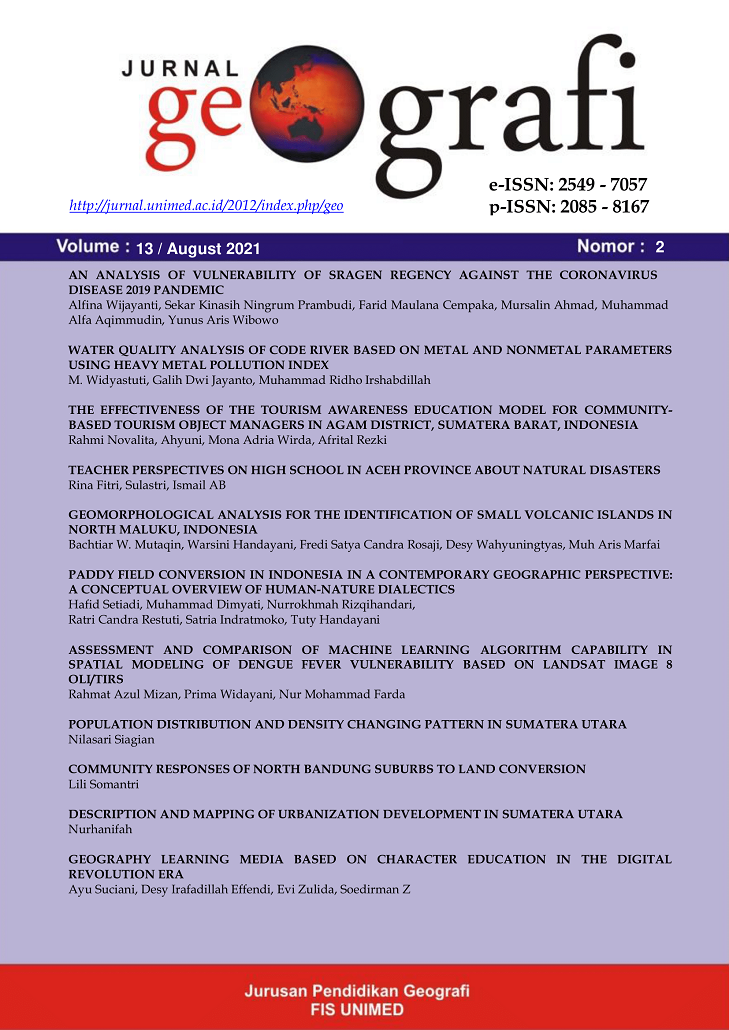PADDY FIELD CONVERSION IN INDONESIA IN A CONTEMPORARY GEOGRAPHIC PERSPECTIVE: A CONCEPTUAL OVERVIEW OF HUMAN-NATURE DIALECTICS
DOI:
https://doi.org/10.24114/jg.v13i2.21027Abstract
Experts from various perspectives have widely reviewed the patterns, processes, reasons, and impacts of paddy field conversion. However, most of these reviews tend to understand paddy fields from the physical-material dimension. By using the perspective of contemporary geography, this paper provides a critical conceptual overview of the conversion of paddy fields through the elaboration of human-nature dialectic as a central theme in the discipline of geography. The dialectic also contains identity, spatial awareness, and spatial-symbolic order issues that affect the existence of farmers and their paddy fields. This critical review results in the argument that the relationship between farmers and paddy fields represents a spatial-symbolic order that contains values, enthusiasm, identity, and living traditions. The identity and existence of farmers are part of the existence of paddy fields. Paddy fields have become part of the minds and consciousness of the farmers. The conversion of paddy fields will reduce the eco-cultural relations in this order and replace it with a capitalistic system.Keywords: contemporary geography, human-nature dialectic, paddy field conversion, spatial-symbolic order, sustainable agricultureReferences
Akintola, J. (2015). What is a Contemporary Geography? Geography Realm cited in https://www.geographyrealm.com/what-is-contemporary-geography [20 November 2020]
Axinn, W.G., & D.J. Ghimire. (2011). Social Organization, Population, and Land Use. American Journal of Sociology, 117 (1), 209-258.
Bappenas (2015). Evaluasi Implementasi Kebijakan Lahan Pertanian Pangan Berkelanjutan (LP2B). Retrieved from:http://www1.bappenas.go.id/files/publikasi_utama/Evaluasi_Implementasi_Kebijakan_Lahan_Pertanian_Pangan_Berkelanjutan_(LP2B).pdf
Buttimer, A. (2015). Diverse Perspective on Society and Environment. IGC Cologne 2012. Down to Earth. Documenting the 32nd International Geographical Congress in Cologne 26-30 August 2012. Geographisches Institut der Universität zu Köln, 41-52
Diamond, J. (2014). Collapse; Runtuhnya Peradaban-Peradaban Dunia. Terj. Damaring Tyas Wulandari Palar Jakarta: KPG
Fikri, G.I. (2020). Pengaruh Institusi Kelompok Tani Terhadap Perubahan Penggunaan Lahan Pertanian Di Wilayah Agropolitan Ciwidey. Skripsi. Program Studi Sarjana Geografi, Fakultas Matematika dan Ilmu Pengetahuan Alam Universitas Indonesia. Depok. 166 hal.
Harrison, P. (2014). Poststructuralist Theory. 132-144 pp. In Aitken, S.C. & G.Valentine. (eds). Approaches to Human Geography. London dan NY: SAGE Publication
Huang, P.C.C., G. Yuan, dan Y. Peng. (2012). Capitalization without Proletarianization in China's Agricultural Development. Modern China, 38 (2), 139-173.
Johnston, R. (2020). Geography. Encyclopedia Britannica cited in https://www.britannica.com/science/geography [20 November 2020]
Ministry of Agriculture. (2015). Rencana Strategis Kementerian Pertanian 2015-2019. Retrieved from: http://sakip.pertanian.go.id/admin/file/Renstra%20Kementan%202015-2019%20(edisi%20revisi).pdf
Ministry of Agriculture. (2016). Statistik Lahan Pertanian Tahun 2011-2015. Retrieved from: http://epublikasi.setjen.pertanian.go.id/arsip-perstatistikan/167-statistik/statistik-lahan/452-statistik-lahan-pertanian-tahun-2011-2015
Ministry of Agriculture. (2018). Indeks Ketahanan Pangan Indonesia 2018. Retrieved from: http://bkp.pertanian.go.id/storage/app/media/Pusat%20Ketersediaan/Bidang%20Ketersediaan/Indeks%20Ketahanan%20Pangan%202018.pdf
Keputusan Menteri ATR/Kepala BPN-RI No. 686/SK-PG.03.03/XII/2019 tentang Penetapan Luas Lahan Baku Sawah Nasional Tahun 2019. Kementerian Agraria dan Tata Ruang/Badan Pertanahan Nasional.
Marshall, T. (2015). Prisoners of Geography: Ten Maps That Explain Everything About The World. London: Elliott & Thompson Limited
Plumer, Q. (2016). Apple iPhone, iPad, iMac, iPod: Here's What The 'i' Means. Tech Times 20 February 2016. Retrieved from: https://www.techtimes.com/articles/135191/20160220/apple-iphone-ipad-imac-ipod-heres-what-the-i-means.htm
Purbiyanti. E., M. Yazid, dan I. Januarti. (2017). Konversi Lahan Sawah di Indonesia dan Pengaruhnya Terhadap Kebijakan Harga Pembelian Pemerintah (HPP) Gabah/Beras. Jurnal Manajemen dan Agribisnis, 14 (3), 209-217.
Quasem, M.A. (2012). Conversion of Agricultural Land to Non-agricultural Uses in Bangladesh: Extent and Determinants. Bangladesh Development Studies, 34 (1), 59-85. https://www.jstor.org/stable/23342764
Rauch, T. (2014). New Ruralities in the Context of Global Economic and Environmental Change - Are Small-Scale Farmers Bound to Disappear? Geographica Helvetica 69 (4), 227-237.
RI (Republik Indonesia). (2011). Peraturan Pemerintah Republik Indonesia Nomor 1 Tahun 2011 tentang Penetapan Alih Fungsi Lahan Pertanian Pangan Berkelanjutan. Lembaran Negara RI Tahun 2011, No. 2. Sekretariat Negara.
RI (Republik Indonesia). (2012). Peraturan Menteri Pertanian Nomor 07 Tahun 2012 tentang Pedoman Teknis Kriteria dan Persyaratan Kawasan, Lahan, dan Lahan Cadangan Pertanian Pangan Berkelanjutan. Berita Negara No 205, 2012. Kementerian Pertanian
Ricklefs, M..C, B. Lockhart, B., A.Lau., P. Reyes., dan M. Aung-Thwin. (2013). Sejarah Asia Tenggara, Dari Masa Prasejarah sampai Kontemporer. Terj. Tim Komunitas Bambu. Jakarta: Komunitas Bambu
Vries, W., & W. Voß. (2018). Economic Versus Social Values in Land and Property Management: Two Sides of the Same Coin?. Raumforschung und Raumordnung. Spatial Research and Planning, 76(5) 381-394.
Wahyunto & F. Widiastuti. (2014). Lahan Sawah sebagai Pendukung Ketahanan Pangan serta Strategi Pencapaian Kemandirian Pangan. Jurnal Sumberdaya Lahan. 8 (3), 17-30.
Wang, J., & Y. Liu. (2013). Tourism-Led Land-Use Changes and their Environmental Effects in the Southern Coastal Region of Hainan Island, China. Journal of Coastal Research, 29 (5), 1118-1125.
























